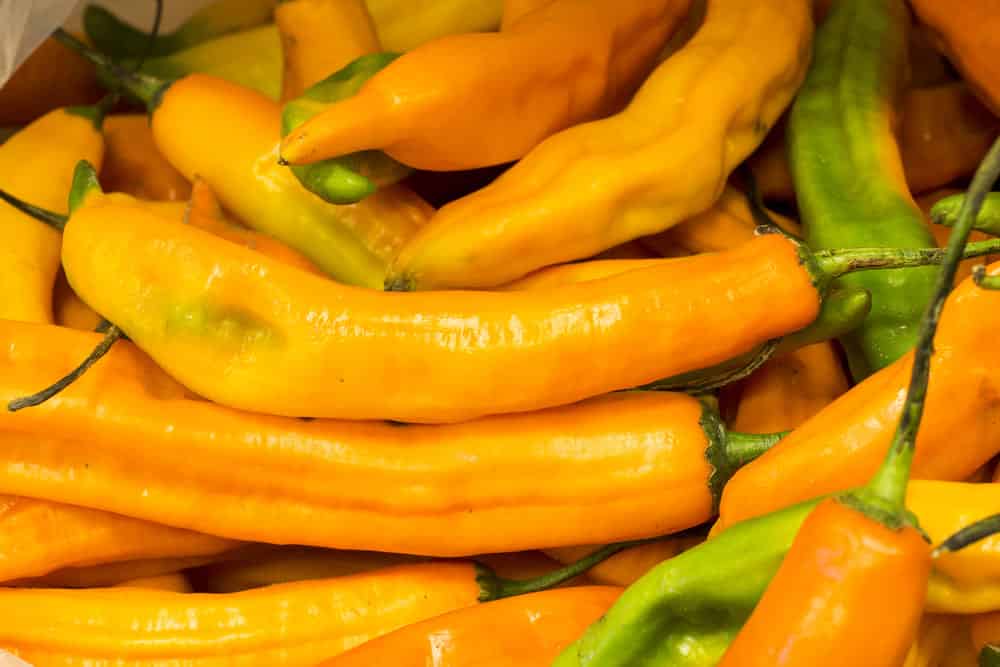
With its roots in Peru, aji pepper is loved throughout the region. Peruvian love this yellow pepper so much that you can observe it in their dishes very often. It is known as yellow pepper because it turns yellow when cooked. The combination of garlic, red onion, and aji pepper represents the rich taste and culture of Peru.
The Aji pepper plant is highly productive, yielding a large amount of pepper. Although many types of aji pepper are found, you may not have them at home every time. So, you would be wondering if there is any decent aji pepper substitute.
Aji Amarillo is the most common variety consumed in Peru and neighboring regions. On the Scoville scale, it has a value of 40,000-50,000 which indicates that the pepper is hot. The flavor is sweet and fruity that balances out the hotness. It is available in fresh, powdered, and dried forms.
This type is surely the most integral part of Peruvian cuisine, as it is added to a number of national dishes. Aji Cito is another variety, and it is the hottest pepper in the family with nearly 100,000 Scovilles. There are numerous other types of aji pepper each with its distinct characteristics.
Aji Pepper Substitutes
1) Habanero pepper
This pepper is hotter as compared to aji pepper. The flavor is unique smoky and citrus-like. The heat of Habanero makes it a popular choice in the culinary world. Chefs in the region combine it with fruits like apples, oranges, and pineapples. You can make flavorful fruit sauces using this.
As a substitute for aji pepper, habanero can add the much-needed unique flavor in most dishes. The color of the habanero is somewhat alike aji pepper too. It’s advisable to handle this pepper while wearing gloves.
Besides its top flavor in various dishes, habanero has many health benefits. Eating these hot and spicy pepper will help reduce LDL i.e., the bad cholesterol. Furthermore, it will lower blood pressure and help you in weight reduction.
2) Scotch Bonnet pepper
Closely related to habanero, the scotch bonnet is a really hot pepper. The color of this pepper is similar to aji pepper. It is yellow or orange on maturation. Scotch bonnet is a great addition because of the bright and fruity flavor. Unlike aji, it originates from the Caribbean but the similarities make it a great alternative.
However, do keep in mind that scotch bonnet has way more heat than the aji. You can use minimal quantities in the recipe to balance out the flavor.
3) Manzano chile
Manzano, an apple look-alike, is a pepper that will never disappoint your fruity taste buds. The heat of this pepper is close to Aji’s. The taste is unique owing to the sweetness and thick walls. You can use it in hot sauces and even pickles. The color is yellowish bright orange, and they are pretty hard to grow.
4) Serrano pepper
It has a decent heat of 10,000 to 23,000 Scovilles. They resemble the jalapeno pepper in color but are smaller. These are versatile as you can use them in sauces, salsas, and garnishes. When roasted, serrano can be a great value addition in traditional Peruvian dishes that require aji pepper. These are easily available and add balanced flavor as they taste just like jalapenos.
5) Frozen or dried aji pepper
Are you a diet freak who loves everything fresh? Sometimes, you have to break some rules. Frozen or dried-out aji pepper is usually available in American Latin stores. Get a bottle to make the recipe in hand if you are not willing to use any of the above-mentioned alternatives.
Frozen or dried aji pepper will also provide some health benefits like fluid regulation, lowering bad cholesterol, and antioxidant effects.
According to Peruvian people, there is no substitute for aji pepper because of its unique and rich flavor. However, at times, it is difficult to find such unique stuff in the market. From national dishes like causa rellena to seafood, it is difficult to regret adding aji pepper. Our list of substitutes can help you in adding the bright and complex flavor of aji pepper. Make sure to use the type that would suit the required hotness and flavor of the dish.